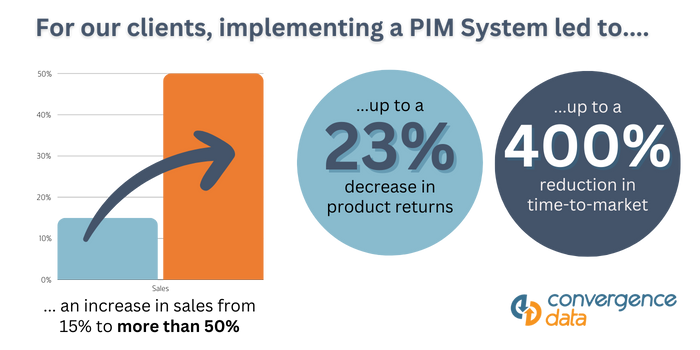Top 10 Requirements of a PIM
💡 The right Product Information Management (PIM) solution can provide a wide range of features tailored to the complex needs of industrial manufacturing companies. Many enterprises attempt to create their own PIM solution in-house and are left with incomplete data, duplicates, and an overly complicated system that is difficult to manage and update. Because of this, many homegrown and legacy PIM solutions fall short of what end users need and customers truly want through a buying experience.

Design For Retrieval, our state-of-the-art SaaS PIM software, was developed with industrial manufacturers and distributors in mind and provides a lightweight usability experience with powerful data modeling, cleansing, and syndication features to make your product data actionable across the business and sharable across your most critical business channels so you and your team can go to market quickly and grow revenue! 💵
Popular PIM Must-Haves
A PIM system can make a major difference in your manufacturing business with the following features:
- Single Source of Truth for Product Data Management: A PIM system should provide a centralized repository for managing all product-related data, including categories, descriptions, specifications, relationships, and more. This centralized approach should ensure data consistency, cleanliness, completeness, and conciseness across all channels. This means getting you and your team out of reliance on offline spreadsheets and into a live database where you can work on your items with real-time project tracking and SKU visibility.
- Ease of Use: A PIM system should allow more end users in the system (product managers, for example) vs. only one or two individuals within IT to make changes to the data. Industrial manufacturers should have the ability to enrich product data by adding attributes, categories, and digital assets with ease. The platform should also include tools for normalizing data formats and ensuring compliance with style guides, industry standards, and critical regulations.
- Working with Data at Scale Across The Enterprise: The PIM solution should support both product and parts data to support a digital thread approach to extending the data across the organization. It should support product data for eCommerce, marketing, channel sales, and aftermarket. Advanced platforms such as our Design for Retrieval PIM can even bridge the gap between Engineering and Marketing by managing technical attribution for parts from an enterprise PLM system. It should also include tools for improving and maintaining data quality across the enterprise, such as bulk data validation rules, duplicate detection, data cleansing capabilities through both in-house or outsourced data factory teams working at scale, and allow access and permissions to support concurrent users.
- Workflows to Support the Way You Do Business: The PIM should have configurable process flows to support activities such as acquisition onboarding, legacy data conversions, new part/product creation, data approval, data validation in bulk, and publishing. The processes should support all data that is distributed to downstream recipients such as strategic channel partners, distributors, and other organizational divisions who need it. This ensures that only accurate, complete, and approved product data and digital assets are published and disseminated that align with your style guide, operations, and ultimately, your critical business needs.
- Multichannel Distribution: Manufacturers should be able to leverage the PIM to distribute product information across multiple sales channels, including e-commerce websites, marketplaces, catalogs, and other important print materials (such as spec sheets, product guides, etc.). The solution should also allow for integrations with e-commerce platforms, ERP systems, and other enterprise systems to streamline data distribution processes.
- Localization, Translation and Regionalization: The PIM should support localization, translation, and regionalization efforts by allowing manufacturers to manage product data in multiple languages, currencies, and regions. It should also include features for managing translated product descriptions, specifications, and other key content.
- Integration with ERP Systems: A PIM solution should integrate with other enterprise systems, such as ERP (Enterprise Resource Planning) to synchronize product data across the organization. This integration streamlines processes related to inventory management, order fulfillment, and customer service.
- Analytics and Reporting: PIM systems provide analytics and reporting capabilities to track key performance indicators (KPIs) related to product data management, such as data completeness (via fill rate reporting), accuracy (via bulk validation rules), and time-to-market. Manufacturers can use these insights to optimize their product information processes and improve their overall efficiency.
- Flexible Data Modeling: A PIM system should offer flexible data modeling capabilities, allowing manufacturers to define custom product attributes, categories, and hierarchies to suit their specific product portfolio and business needs.
- Scalability and Customization: Finally, PIM systems should be scalable and customizable to accommodate the growing needs of manufacturing companies. Since the PIM will often need to support large (and often complex) product catalogs, complex data structures, and custom process flows, a solution that is both flexible and scalable will help to support businesses of all sizes and across many industries.
✍️ Contact us today to explore how to get started with DFR PIM or migrate off of your legacy PIM! Our SaaS solution is leveraged across many industrial manufacturers today to scale, centralize, govern, and distribute their most critical product data with downstream distributors and internal business teams alike. With over 20 years of taxonomy and data cleansing expertise, our team stands ready to support you in meeting your eCommerce, Aftermarket and digital thread goals!


